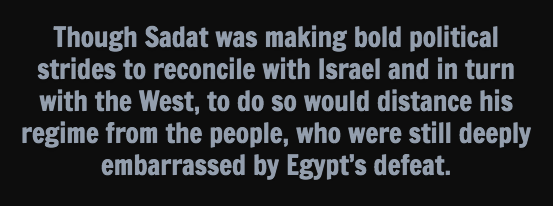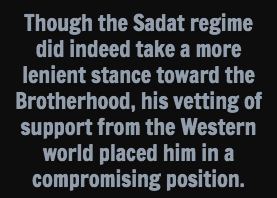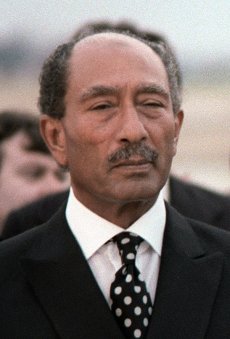Anwar Sadat was a colleague of Nasser and participated in the Free Officer revolts. However, unlike Nasser, Sadat had no desire to align himself with the pro-socialist pan-Arab ideals that Nasser had become known for. After Nasser’s death, and Sadat’s rise as President of Egypt, the Brotherhood began to enjoy the benefits of once again operating out in the open, something they had been prevented from doing under Nasser. Sadat felt that Islamist groups such as the Muslim Brotherhood could counterbalance the unwanted influence of the Nasserite and Leftist elements that had enjoyed support when Nasser had been alive.[1] During this period, the Brotherhood was able to once again expand their efforts outside hidden backrooms and hushed conversation. Under Sadat’s rule, the Brotherhood was able to expand their membership into the established middle class, which had been all but decimated by Nasser.[2]
Perhaps most important of the changes of the Sadat era was his abolishment of the one-party system of government instituted by Nasser. The Arab Socialist Union adopted by Nasser had served as the sole party in Parliament. This one party represented the whole of Egypt and prevented groups such as the Muslim Brotherhood the opportunity to mobilize politically. This signaled a new period in the history of the Brotherhood, as the possibility of real political power became a reality, and the Brotherhood was afforded the chance to begin making plans for the future. Sadat ratified a constitution in 1971, replacing the one-party system with a multi-party system[3], as well as securing Islam as the religion of the state, Arabic as the official language, and sharia as a principle source of legislation[4]. Sadat was turning into a savior for the Brotherhood, as his image as the “believer president” provided the Brotherhood the legitimacy to operate more openly.[5] It is at this point that the Muslim Brotherhood had to decide what were its political aspirations.
 Sadat instituted sweeping changes at the beginning of his rule. Perhaps the most significant for the Brotherhood were Sadat’s aspirations of reconciliation with Israel. It is important to note how the Brotherhood’s position affected their relationship with Sadat, as his lax policies toward Israel conflicted with the Brotherhood’s view. Sadat was bidding for support from the West, who was eager to see the hostilities between Israel and the Arab world cease. The Brotherhood would be immovable in their opinion, though later in their history their position eased. The Brotherhood understood itself to be maintaining the general opinion of the Egyptian people, still raw from defeat in the 1967 war. Though Sadat was making bold political strides to reconcile with Israel and in turn with the West, to do so would distance his regime from the people, who were still deeply embarrassed by Egypt’s defeat.
Sadat instituted sweeping changes at the beginning of his rule. Perhaps the most significant for the Brotherhood were Sadat’s aspirations of reconciliation with Israel. It is important to note how the Brotherhood’s position affected their relationship with Sadat, as his lax policies toward Israel conflicted with the Brotherhood’s view. Sadat was bidding for support from the West, who was eager to see the hostilities between Israel and the Arab world cease. The Brotherhood would be immovable in their opinion, though later in their history their position eased. The Brotherhood understood itself to be maintaining the general opinion of the Egyptian people, still raw from defeat in the 1967 war. Though Sadat was making bold political strides to reconcile with Israel and in turn with the West, to do so would distance his regime from the people, who were still deeply embarrassed by Egypt’s defeat.
 Sadat’s regime heralded in not only changes in policy, intended to separate itself from those of Nasser, but perhaps more importantly a close aligning with the “Western” world. Discussed above, the criticism of Sayyid Qutb on American i.e. Western culture was aimed not only at the West, but also the Nasser regime and his nationalistic policies. Inheriting Nasser’s tendency to lean away from the Brotherhood’s Islamic message would serve to sour the Brotherhood’s impression of him. Though the Sadat regime did indeed take a more lenient stance toward the Brotherhood, his vetting of support from the Western world placed him in a compromising position.
Sadat’s regime heralded in not only changes in policy, intended to separate itself from those of Nasser, but perhaps more importantly a close aligning with the “Western” world. Discussed above, the criticism of Sayyid Qutb on American i.e. Western culture was aimed not only at the West, but also the Nasser regime and his nationalistic policies. Inheriting Nasser’s tendency to lean away from the Brotherhood’s Islamic message would serve to sour the Brotherhood’s impression of him. Though the Sadat regime did indeed take a more lenient stance toward the Brotherhood, his vetting of support from the Western world placed him in a compromising position.
The period of Sadat’s administration saw both the collapse of the Shah in Iran and the beginning of the Soviet Union’s involvement in Afghanistan. The fall of the Shah’s secular government in Iran in favor of a more Islamic government was in stark contrast to the situation in Soviet-occupied Afghanistan. On one hand, the Western-backed Shah in Iran had been replaced with a more Islamic based form of government, while on the other hand the Soviet Union was battling an increasingly resourceful resistance movement in Afghanistan. The Shah in Iran and the Soviet Union in Afghanistan represented imperialistic involvement in Muslim countries. The ongoing violence in Afghanistan highlighted the struggle against imperialism, personified in this case by the Soviet Union. I call both the United States and the Soviet Union Imperial here, so that I can show how the Iranian Revolution and Soviet occupied Afghanistan was considered a Muslim/Arab versus Imperial struggle. Devout Muslims around the World were watching the Soviet invasion of Afghanistan, and the Iranian Revolution with interest. In Egypt, images of Iran and Afghanistan were being cast alongside those of Sadat signing peace accords with Israel at Camp David, and of Sadat winning the Nobel Peace Prize in Norway. To the Muslim Brotherhood, Sadat was winning favor with the West while the Western powers were systematically repressing the Arab and Muslim world.
![Queen Farah Diba of Iran, President Anwar Sadat of Egypt, and Mohammad Reza Pahlavi, Shah of Iran. Image courtesy of Kayhan Int. (Kayhan International) [Public domain], via Wikimedia Commons](https://pathtothepresidency.files.wordpress.com/2013/04/queen_farah_of_persia_egyption_president_anwar_sadat_mohammad_reza_shah_pahlavi_of_persia_1975.jpg?w=271&h=157)
Queen Farah Diba of Iran, President Anwar Sadat of Egypt, and Mohammad Reza Pahlavi, Shah of Iran.
Image courtesy of Kayhan Int. (Kayhan International) [Public domain], via Wikimedia Commons
The Brotherhoods political aspirations had not solidified in the period before the Sadat regime. Before Sadat, the Brotherhood had not been presented a scenario where express political participation was an option. The growing support for the Brotherhood concerned Sadat, in that their growing number would support a future organization that stood in opposition to Sadat’s government. To alleviate those concerns, Sadat offered the Brotherhood an opportunity to participate in parliament through the political parties that arose from the abolishment of the single party system under Nasser.[6] The Brotherhood, under General Guide Umar Al Tilemensani, declined due to the belief that participation in a secular government would negatively impact the Brotherhood’s image as an Islamist organization.[7] Anwar Sadat would be assassinated on October 6, 1981 by what some believe to be ex-members of the Muslim Brotherhood. Sadat’s death would herald in a new era of political participation for the Brotherhood, as well as political oppression under Hosni Mubarak.
[1] Saad Eddin Ibrahim. Egypt, Islam, and Democracy: Twelve Critical Essays. (Cairo, Egypt: American University of Cairo Press, 1996.), 36.
[2] Mariz Tadros, The Muslim Brotherhood in Contemporary Egypt: Democracy Redefined or Confinded? (London and New York, Routledge Press, 2012), 6.
[3] Saad Eddin Ibrahim. Egypt, Islam, and Democracy: Twelve Critical Essays. (Cairo, Egypt: American University of Cairo Press, 1996.), 37.
[4] Mohammed Zahid. The Muslim Brotherhood and Egypt’s Succession Crisis. (London and New York, I.B. Tauris Publishers, 2010), 82.
[5] Ibid., 82.
[6] Mohammed Zahid. The Muslim Brotherhood and Egypt’s Succession Crisis. (London and New York, I.B. Tauris Publishers, 2010), 92.
[7] Ibid., 92.
